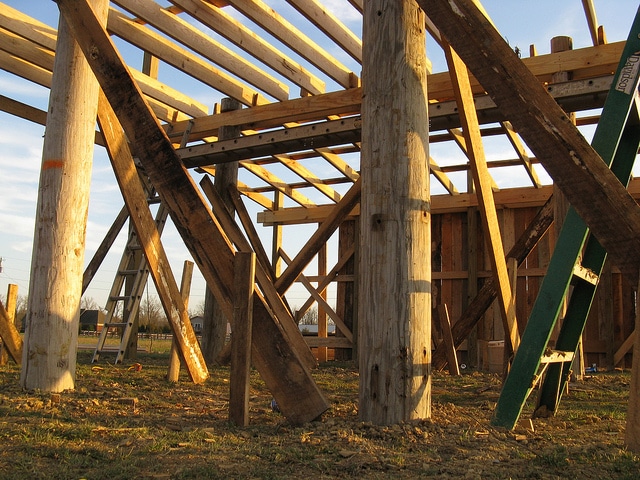[av_section min_height=” min_height_px=’500px’ padding=’default’ shadow=’no-shadow’ bottom_border=’no-border-styling’ bottom_border_diagonal_color=’#333333′ bottom_border_diagonal_direction=’scroll’ bottom_border_style=’scroll’ scroll_down=” id=” color=’main_color’ custom_bg=” src=” attach=’scroll’ position=’top left’ repeat=’no-repeat’ video=” video_ratio=’16:9′ video_mobile_disabled=” overlay_enable=” overlay_opacity=’0.5′ overlay_color=” overlay_pattern=” overlay_custom_pattern=”]
[av_textblock size=” font_color=” color=” custom_class=”]
You want something simple. Just a place to store hay, grain, or some tractors, trailers and attachments, or maybe just a place to host parties in the nicer months. Common sense might say all you need is a roof overhead and not much else, so a roof-only pole barn might be a good choice. And honestly, it just might! Depending on your exact needs, the builder you choose and the amount you’re willing to pay for your pole barn, it might be the best choice for you.
However, roof-only pole barns do present some unique challenges that walled pole barns do not, which, if not known, may cost you extra cash or end up losing you your entire building.
[/av_textblock]
[av_two_third first min_height=” vertical_alignment=” space=” custom_margin=” margin=’0px’ padding=’0px’ border=” border_color=” radius=’0px’ background_color=” src=” background_position=’top left’ background_repeat=’no-repeat’ animation=” mobile_display=”]
[av_heading heading=’Disadvantages’ tag=’h2′ style=” size=” subheading_active=” subheading_size=’15’ padding=’10’ color=” custom_font=” custom_class=”][/av_heading]
[av_textblock size=” font_color=” color=” custom_class=”]
Without sidewalls, the columns must do much more work when it comes to support the roof as well as withstanding force from the wind. You might not think this is much, but it can mean the columns need to be quite a bit thicker and much better connected to offset the force.
Another disadvantage is that without walls, any hay or grain you store underneath the pole barn is more likely to experience spoilage, as rain rarely falls straight down from the sky. Walls can truly be the gift that keeps on giving for spoilage or for wear and tear on your vehicles, tractors and trailers.
[/av_textblock]
[av_textblock size=” font_color=” color=” custom_class=”]
Without sidewalls, the columns must do much more work when it comes to support the roof as well as withstanding force from the wind. You might not think this is much, but it can mean the columns need to be quite a bit thicker and much better connected to offset the force.
Another disadvantage is that without walls, any hay or grain you store underneath the pole barn is more likely to experience spoilage, as rain rarely falls straight down from the sky. Walls can truly be the gift that keeps on giving for spoilage or for wear and tear on your vehicles, tractors and trailers.
[/av_textblock]
[/av_two_third][av_one_third min_height=” vertical_alignment=” space=” custom_margin=” margin=’0px’ padding=’0px’ border=” border_color=” radius=’0px’ background_color=” src=” background_position=’top left’ background_repeat=’no-repeat’ animation=” mobile_display=”]
[av_image src=’https://lumber-one.com/wp-content/uploads/2016/06/4479894901_70fbee7d9c_z-1-300×225.jpg’ attachment=’1376′ attachment_size=’medium’ align=’center’ styling=” hover=” link=” target=” caption=” font_size=” appearance=” overlay_opacity=’0.4′ overlay_color=’#000000′ overlay_text_color=’#ffffff’ animation=’no-animation’ custom_class=”][/av_image]
[/av_one_third][av_heading heading=’The Science Behind The Wind’ tag=’h2′ style=” size=” subheading_active=” subheading_size=’15’ padding=’10’ color=” custom_font=” custom_class=”][/av_heading]
[av_textblock size=” font_color=” color=” custom_class=”]
Without walls, a pole-barn basically becomes an airplane wing. In aerodynamics, the wind moving over the top of a wing (or roof in this case) moves slower than the wind moving under the roof, which gets a boost. The wind underneath the roof then passes through, hitting the slower moving wind coming from the top of the roof, creating an effect similar to a wall at the front of the building. This means pressure from the wind is transferred down and up. Since the ground below isn’t going to move, it puts extra force toward the roof, which if not properly built can lead it to rip off or pull the whole building out of its foundation!
[/av_textblock]
[av_heading heading=’How To Diminish The Risk’ tag=’h2′ style=” size=” subheading_active=” subheading_size=’15’ padding=’10’ color=” custom_font=” custom_class=”][/av_heading]
[av_textblock size=” font_color=” color=” custom_class=”]
Because of the reality of wind, there are some special engineering considerations which need to be made during the design phase of a pole barn.
To protect the roof from popping off or the structure from releasing from the ground, the columns need to be thicker, the roof needs to be built stronger with more trusses, truss connectors, truss bracings and tighter purlins. Column will need to be quite a bit thicker, the holes they are set in will need to be deeper and wider, and more concrete will be needed to anchor them. With all of these adjustments, it shouldn’t be a surprise if a roof-only pole barn costs more than a conventional design!
If you’d like to learn more about whether a roof-only or walled pole barn is right for your needs, get in touch with Lumber One today.
[/av_textblock]
[/av_section]

